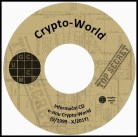Crypto - News
Crypto - News | Security - News
IETF pkix - návrh nových paremetr? eliptických k?ivek - k diskusi
15.08.2006Z informace:
I would like to propose a new contribution to PKIX, which has been prepared by the ECC Brainpool, a working group of companies and institutions engaged in elliptic curve cryptography.
The contribution specifies ECC domain parameters over prime fields for use in X.509 conforming PKIs. It can be downloaded here http://www.ecc-brainpool.org/download/draft_pkix_additional_ecc_dp.txt
We are aware that the domain parameters recommended by ANSI X9.62 are already widely employed. The specification of additional parameters is motivated by the following facts:
1. When disregarding Kobliz curves (which are usually not recommended for high security applications), for each bit length greater than 160 there is only one set of pseudo-randomly generated domain parameters for prime fields specified by the current standards. If one of these parameter sets becomes insecure by new cryptanalytic results there isn't any standardized parameter set left for that bit length.
2. Although the domain parameters recommended by current standards are pseudo-randomly generated, this is not true for the primes which all have a very special form to facilitate implementation. Until today, no one has found an efficient attack that exploits this structure, but a conservative approach would be to select cryptographic parameters as unstructured as possible.
3. Current standards do not motivate the selection of the seeds. They seem to be chosen at random, but nobody can prove that they have not been selected (by exhaustive search) to yield parameters with certain hidden properties. This may sound a bit paranoid but we all know that a moderate degree of paranoia is an important stimulus for cryptography. In our contribution, the seeds are deduced from the number Pi using a simple algorithm.
4. Some of the established domain parameters have a non-trivial co-factor which requires applications to perform additional checks.
Further differences to the domain parameter specifications of X9.62 are:
5. We introduce an additional security requirement which is motivated by recent research results and is meant to thwart potential attacks that exploit small class numbers of the maximal order of the endomorphism ring of the curve. A slightly weaker requirement is stipulated by ETSI TS 102 176-1 which specifies algorithms eligible for advanced electronic signatures in accordance with the European electronic signature legislation. 6. X9.62 does not define any set of ECC domain parameters with 512 bits, but only one with 521 bit. Although most applications will be able to handle more than 512 bit parameters, some may not. We propose a parameter set with natural length of 512 bit.
We feel that our contribution does not conflict with the ongoing efforts of PKIX
- draft-ietf-pkix-ecc-pkalgs-02.txt
- draft-ietf-pkix-sha2-dsa-ecdsa-00.txt
but rather complements them. It does not define any new ASN.1 syntax but recommends complying with draft-ietf-pkix-ecc-pkalgs-02.txt.
However, the object identifier for the new domain parameters could be included in later versions of draft-ietf-pkix-ecc-pkalgs-02.txt.
Kind regards, Johannes Merkle
Zdroj: http://www.ecc-brainpool.org/download/draft_pkix_additional_ecc_dp.txtI would like to propose a new contribution to PKIX, which has been prepared by the ECC Brainpool, a working group of companies and institutions engaged in elliptic curve cryptography.
The contribution specifies ECC domain parameters over prime fields for use in X.509 conforming PKIs. It can be downloaded here http://www.ecc-brainpool.org/download/draft_pkix_additional_ecc_dp.txt
We are aware that the domain parameters recommended by ANSI X9.62 are already widely employed. The specification of additional parameters is motivated by the following facts:
1. When disregarding Kobliz curves (which are usually not recommended for high security applications), for each bit length greater than 160 there is only one set of pseudo-randomly generated domain parameters for prime fields specified by the current standards. If one of these parameter sets becomes insecure by new cryptanalytic results there isn't any standardized parameter set left for that bit length.
2. Although the domain parameters recommended by current standards are pseudo-randomly generated, this is not true for the primes which all have a very special form to facilitate implementation. Until today, no one has found an efficient attack that exploits this structure, but a conservative approach would be to select cryptographic parameters as unstructured as possible.
3. Current standards do not motivate the selection of the seeds. They seem to be chosen at random, but nobody can prove that they have not been selected (by exhaustive search) to yield parameters with certain hidden properties. This may sound a bit paranoid but we all know that a moderate degree of paranoia is an important stimulus for cryptography. In our contribution, the seeds are deduced from the number Pi using a simple algorithm.
4. Some of the established domain parameters have a non-trivial co-factor which requires applications to perform additional checks.
Further differences to the domain parameter specifications of X9.62 are:
5. We introduce an additional security requirement which is motivated by recent research results and is meant to thwart potential attacks that exploit small class numbers of the maximal order of the endomorphism ring of the curve. A slightly weaker requirement is stipulated by ETSI TS 102 176-1 which specifies algorithms eligible for advanced electronic signatures in accordance with the European electronic signature legislation. 6. X9.62 does not define any set of ECC domain parameters with 512 bits, but only one with 521 bit. Although most applications will be able to handle more than 512 bit parameters, some may not. We propose a parameter set with natural length of 512 bit.
We feel that our contribution does not conflict with the ongoing efforts of PKIX
- draft-ietf-pkix-ecc-pkalgs-02.txt
- draft-ietf-pkix-sha2-dsa-ecdsa-00.txt
but rather complements them. It does not define any new ASN.1 syntax but recommends complying with draft-ietf-pkix-ecc-pkalgs-02.txt.
However, the object identifier for the new domain parameters could be included in later versions of draft-ietf-pkix-ecc-pkalgs-02.txt.
Kind regards, Johannes Merkle
Autor: JP

